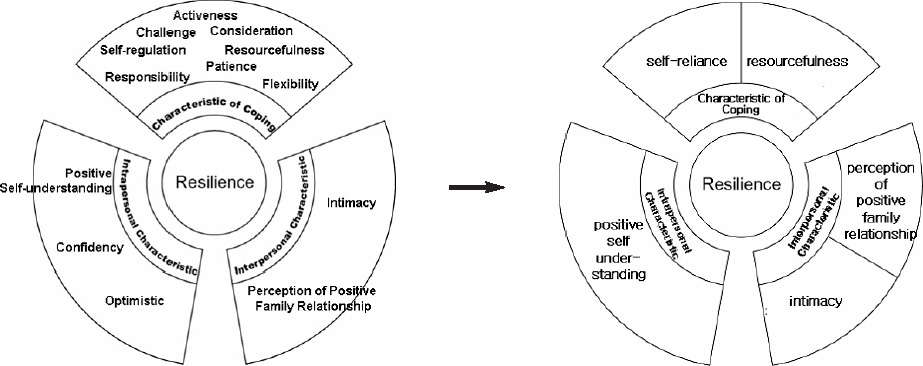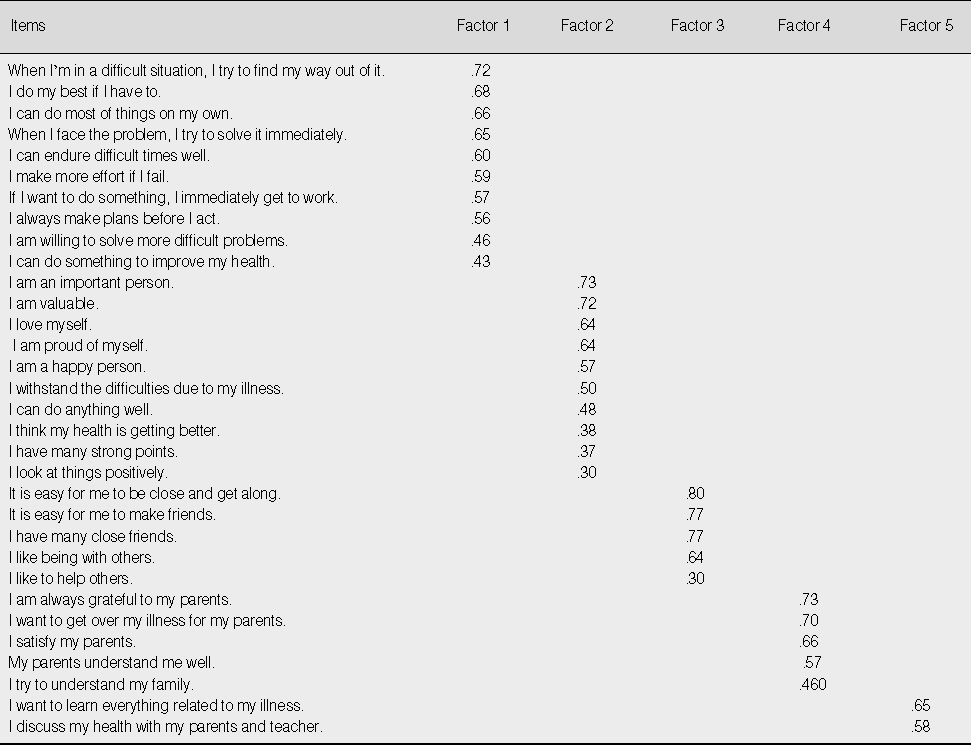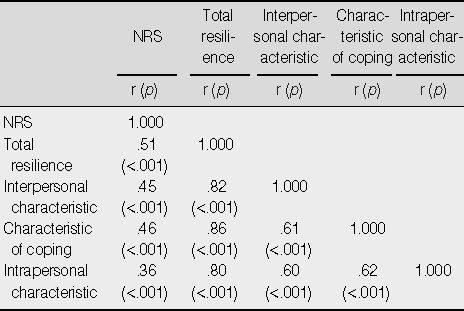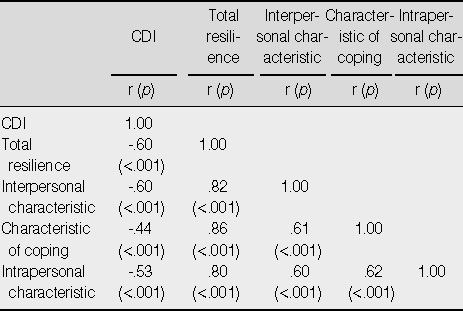Articles
- Page Path
- HOME > J Korean Acad Nurs > Volume 40(2); 2010 > Article
-
Original Article
- Development of a Questionnaire to Measure Resilience in Children with Chronic Diseases
- Dong Hee Kim, Il Young Yoo
-
Journal of Korean Academy of Nursing 2010;40(2):236-246.
DOI: https://doi.org/10.4040/jkan.2010.40.2.236
Published online: April 30, 2010
1Assistant Professor, Sungshin Women's University College of Nursing, Seoul, Korea.
2Professor, Yonsei University College of Nursing, Seoul, Korea.
- Address reprint requests to: Yoo, Il Young. Yonsei University College of Nursing, 34 Sinchon-dong, Seodaemun-gu, Seoul 120-752, Korea. Tel: 82-2-2228-3273, Fax: 82-2-392-5440, iyoo@yuhs.ac
• Received: December 17, 2009 • Revised: December 23, 2009 • Accepted: March 24, 2010
Copyright © 2010 Korean Society of Nursing Science
Abstract
-
Purpose
- The purpose of this study was to develop and evaluate a Korean questionnaire to measure resilience in children with chronic illness.
-
Methods
- Item construction was drawn from an extensive review of the literature, existing questionnaires and interviews with parents. Content validity was tested by experts. To further refine the questionnaire and test its reliability and validity, data were collected from the 202 children with asthma, diabetes mellitus or nephrotic syndrome. Corrected items were used to total correlation coefficient and test-retest reliability. Questionnaire testing was conducted using factor analysis, Cronbach's α, and correlation coefficients. Validity of the questionnaire was tested using internal consistency, construct validity, and criterion-related validity.
-
Results
- Components of the questionnaire were in three domains; interpersonal characteristics, characteristics of coping, and intrapersonal characteristics. Factor analysis is showed five factors; positive self-understanding, self-reliance, resourcefulness, perception of positive family relationships, and intimacy. The questionnaire showed a high internal consistency. A significant positive correlation with the Numerical Rating Score and negative correlation with the Child Depression Inventory support the validity of the questionnaire.
-
Conclusion
- This instrument demonstrated high reliability and validity. Therefore, this instrument can contribute to the evaluation of resilience of chronically ill children and to any subsequent intervention as well as to develop a theory for resilience.
This article is a condensed form of the first author's doctoral dissertation from Yonsei University.
- 1. Brown RT, Lambert R, Devine D, Baldwin K, Casey R, Doepke K, et al. Risk-resistance adaptation model for caregivers and their children with sickle cell syndromes. Annals of Behavioral Medicine. 2000;22:158–169.ArticlePubMed
- 2. Cho SC, Lee YS. Development of the Korean form of the Kovacs'Children's Depression Inventory. Journal of Korean Neuropsychiatric Association. 1990;29:943–956.
- 3. Choi BG. Child development. 1993;Seoul, Hyung-Seul.
- 4. Conner KM, Davison JR. Development of a new resilience scale: The Conner Davison Resilience Scale (CD-RISC). Development and Anxiety. 2003;18:76–82.PubMed
- 5. Egeland B, Carlson E, Sroufe LA. Resilience as process. Development and Psychopathology. 1993;5:517–528.Article
- 6. Haase JE, Heiney SP, Ruccione KS, Stutzer C. Research triangulation to derive meaning-based quality-of-life theory: Adolescent resilience model and instrument development. International Journal of Cancer. 1999;12:Supp. 125–131.PubMed
- 7. Harter SL. Resilient children of alcoholics. 1990;Atlanta, USA, Georgia State University. Unpublished doctoral dissertation.
- 8. Herman-Stahl M, Petersen AC. The protective role of coping and social resources for depressive symptoms among young adolescents. Journal of Youth Adolescence. 1996;25:733–753.ArticlePDF
- 9. Humphreys JC. Turnings and adaptations in resilient daughtersof battered women. Journal of Nursing Scholarship. 2001;33:245–251.ArticlePubMed
- 10. Kallich JD, Tchekmedyian NS, Damiano AM, Shi J, Black JT, Erder MH. Psychological outcomes associatedwith anemia-related fatigue in cancer patients. Oncology. 2002;16:117–124.PubMed
- 11. Kaplan HB. Toward an understanding of resilience: A critical review of definitions and models. 1999;New York, NY, Plenum.
- 12. Kim JS, Lee HJ, Jung KP. SAS guide for user. 1996;Seoul, Hong-Jin.
- 13. Kinard EM. Methodological issues in assessing resilience in maltreated children. Child Abuse & Neglect. 1998;22:669–680.Article
- 14. Lee BH, Sohn JH. Critical review on pain measurements in normal men and pain patients. Korean Journal of Clinical Psychology. 1996;15:163A–188A.
- 15. Lee EH. Assessment and evaluation of child development. 2000;Seoul, Kyo-Mun.
- 16. Lee EH, Shin S, Song YJ. Development of a self-perception scale for elementary school children. Human Ecology Research. 1992;6:175–191.
- 17. Lee EO, Im NY, Park HA. Nursing·medical research and statistics. 1998;Seoul, Su-Moon Sa.
- 18. Luthar SS, Cicchetti D, Becker B. The construct of resilience: A critical evaluation and guidelines for future work. Child Development. 2000;71:543–562.ArticlePubMedPMCPDF
- 19. Luthar SS, Cushing G. Substance use and personal adjustment among disadvantaged teenagers: A six-month prospective study. Journal of Youth and Adolescence. 1997;26:353–372.ArticlePDF
- 20. Mandleco BL, Peery JC. An organizational framework for conceptualizing resilience in children. Journal of Child and Adolescent Psychiatric Nursing. 2000;13:99–111.ArticlePubMed
- 21. Pless IB, Douglas JB. Chronic illness in childhood:Epidemiological and clinical characteristics. Pediatrics. 1971;47:405–414.PubMed
- 22. Rende RD, Plomin R. Child and parent perceptions of the upsettingness of major life events. Journal of Child Psychol-ogy and Psychiatry. 1991;32:627–633.Article
- 23. Tiet QQ, Bird HR, Davies M, Hoven C, Cohen P, Jensen PS, et al. Adverse life events and resilience. Journal of the American Academy of Child. Adolescent Psychiatry. 1998;37:1191–1200.
- 24. Vaillant GE, Davis J. Social/emotional intelligence and midlife resilience in school boys with low tested intelligence. American Journal of Orthopsychiatry. 2000;70:215–222.ArticlePubMed
- 25. Wagnild GM, Young HM. Development and psychometric evaluation of the resilience scale. Journal of Nursing Measurement. 1993;1:165–178.PubMed
- 26. Wasner M, Longaker C, Fegg MJ, Borasio GD. Effects of spiritual care training for palliative care professionals. Palliative Medicine. 2005;19:99–104.ArticlePubMedPDF
- 27. Wikes G. A second generation of resilience research. Journal of Clinical Psychology. 2002;58:229–232.PubMed
- 28. Yoo KH. A correlational study on uncertainty, mastery and appraisal of uncertainty in hospitalized children's mothers. Journal of Korean Academy of Nursing. 2007;37:594–602.ArticlePubMedPDF
REFERENCES
Figure & Data
REFERENCES
Citations
Citations to this article as recorded by 

- Qualitative Content Analysis of the Resilience Scale for Patients With Kidney Transplantation
Mi Ha Chung
Journal of Renal Care.2025;[Epub] CrossRef - Development and Validation of the Resilience Scale for Kidney Transplantation (RS-KTPL)
Mi Ha Chung, Hyojung Park
Asian Nursing Research.2024; 18(2): 167. CrossRef - A disease‐targeted picture book for children with Henoch‐Schonlein purpura nephritis: A quasi‐experimental study
Yao Tang, Weiti Chen, Jingping Li, Yuqian Deng, Shibo Liu, Xia Zhou, Jianhui Xie, Chaohong Zhan, Xianhong Li
Journal of Renal Care.2023; 49(4): 243. CrossRef - Defining and Measuring Resilience in Children with a Chronic Disease: a Scoping Review
Sabine E. I. van der Laan, Emma E. Berkelbach van der Sprenkel, Virissa C. Lenters, Catrin Finkenauer, Cornelis K. van der Ent, Sanne L. Nijhof
Adversity and Resilience Science.2023; 4(2): 105. CrossRef - Development of Resilience Scale for Adolescent Allergic Children
Yoshie Shimizu, Takanori Imai, Tsutomu Matsumoto, Kazuo Nonomura, Taro Kamiya, Yuki Okada, Aiko Honda
Nihon Shoni Arerugi Gakkaishi. The Japanese Journal of Pediatric Allergy and Clinical Immunology.2022; 36(5): 499. CrossRef - Less is more. Discovering the latent factors of trait resilience
John Maltby, Sophie S. Hall
Journal of Research in Personality.2022; 97: 104193. CrossRef - Effects of the Mother-Medical Staff Partnership on Mothers’ Condition Management Ability for Children with Chronic Allergic Diseases
Hae Kyoung Son, Hyo Bin Song, Dong Hee Kim
Child Health Nursing Research.2018; 24(1): 101. CrossRef - Association of Resilience and Depression with Self-care Competence in Adult Patients with Diabetes Mellitus
Youngrye Park, Eun Hee Jang, Ji Ok Kim
Korean Journal of Adult Nursing.2018; 30(5): 555. CrossRef - Development of Resilience Scale for Nurses
Mi Mi Park, Jee-Won Park
Journal of Korean Academy of Fundamentals of Nursing.2016; 23(1): 32. CrossRef - Health Impaired Children's Participation Experience of Hospital School Programs as Perceived by Mothers
Hyun Jung Yun
Journal of Korean Public Health Nursing.2015; 29(3): 515. CrossRef - Predictors of Resilience in Adolescents with Leukemia
Sung Sil Hong, Ho Ran Park
Journal of Korean Academy of Nursing.2015; 45(4): 595. CrossRef - Resilience as a protective factor for the behavioral problems in school-aged children with atopic dermatitis
Dong Hee Kim, Yeo Jin Im
Journal of Child Health Care.2014; 18(1): 47. CrossRef - Predictors of Resilience in Adolescents with Cancer.
Young Ok Park, Gwi Ryung Son Hong, Young Ran Tak
Child Health Nursing Research.2013; 19(3): 177. CrossRef - Factors associated with the resilience of school‐aged children with atopic dermatitis
Yeo Jin Im, Dong Hee Kim
Journal of Clinical Nursing.2012; 21(1-2): 80. CrossRef - Relationship among Perception of Parenting Attitude, Behavior Problems and Resilience of School Age Children
Hyun-Jung Yun, Il-Young Yoo, Eui-Geum Oh
Journal of Korean Academy of Child Health Nursing.2011; 17(3): 174. CrossRef
Development of a Questionnaire to Measure Resilience in Children with Chronic Diseases

Figure 1
Initial and final instrument components.
Figure 1
Development of a Questionnaire to Measure Resilience in Children with Chronic Diseases
Demographic Characteristics of Participants (N=202)
Factor analysis
Correlation of Resilience Score and Numerical Rating Score (N=185)
NRS=numerical rating score.
Correlation of Resilience Score and Child Depression Index Score (N=201)
CDI=child depression index.
Table 1
Demographic Characteristics of Participants (N=202)
Table 2
Factor analysis
Table 3
Correlation of Resilience Score and Numerical Rating Score (N=185)
NRS=numerical rating score.
Table 4
Correlation of Resilience Score and Child Depression Index Score (N=201)
CDI=child depression index.
 KSNS
KSNS
 E-SUBMISSION
E-SUBMISSION





 Cite
Cite

